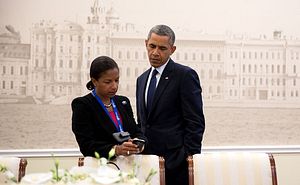Today, the Obama White House released its second and final national security strategy (NSS), outlining in broad strokes the strategic vision of the U.S. president and his national security team. Overall, the white paper places a premium on U.S. leadership in the world: “The strategy sets out the principles and priorities that describe how America will lead the world toward greater peace and a new prosperity.” The New York Times notes that the words “lead” and “leadership” are used almost a hundred times in the document, a hint that the administration is consciously trying to refute accusations by critics that the White House lack assertiveness on the international stage.
The NSS emphasizes that it is meant to clarify “the purpose and promise of American power.” The 29-page document, required by Congress, differs from its 2010 predecessor, which mostly centered on ending the wars in Afghanistan and Iraq, finding a way out of the global financial crisis, and“resetting” the relationship with Russia. Today, in an event at the Brookings Institution, U.S. National Security Advisor Susan Rice, presented the NSS to the broader American public, and stated that, “2015 is a whole new ballgame [and] much has changed in the past five years (…) [yet] what’s missing in Washington is often a sense of long-term perspective.”
Consequently, the focus of the 2015 NSS is on long-term challenges such as cybersecurity, global health, climate change, failing states, and energy security. The strategy also lays out in broad strokes the United States’ commitment to rebalancing to Asia and the Pacific region, pursuing a stable Middle East and North Africa by “reducing the underlying sources of conflict,” eliminating global poverty within 15 years, strengthening global alliances (especially with NATO and European allies given the Ukraine crisis and the worsening relationship with Russia), maintaining multilateral partnerships, reinforcing/updating international norms and institutions, preventing “mass atrocities,” and pushing nuclear non-proliferation.
In detail, the document mentions that the Obama Administration will endeavor to prevent Iran from getting nuclear weapons, persist in the fight against al-Qaeda, ISIL, and their affiliates, pursue the Trans-Pacific Partnership (TPP) and Transatlantic Trade and Investment Partnership (TTIP), carry on its campaign to battle Ebola through the Global Health Security Agenda (GHSA), continue to confront “the urgent crisis of climate change,” support countries such as Tunisia and Burma that are transitioning from authoritarianism “ in their quest towards democracy,” and “impose costs on malicious cyberactors,” among a host of other priorities. The strategy also calls for an end to “draconian cuts imposed by sequestration that threaten the effectiveness of our military and other instruments of power.”
As expected, the document does not outline detailed strategies and plans to accomplish the national security priorities mentioned in the publication. “It serves as a compass for how this administration, in partnership with Congress, will lead the world through a shifting security landscape toward a more durable peace and a new prosperity,” according to Bernadette Meehan, the National Security Council spokeswoman. “In their aspirations, generalities and rhetoric, they often resemble most a really, really long speech,” states a former White House official quoted by Reuters. Over at Foreign Policy, two former National Security Council staffers note that national security strategies “tend to lack the traditional attributes of strategy — that is, they do not spell out desired objectives, articulate the steps needed to achieve those ends, and then describe the resources necessary to carry out those steps.”
Yet, they also notes that the publication of the document is not a waste of time,”because drafting and publishing a National Security Strategy is one governmental exercise in which the process matters more than the product. In producing a NSS, foreign policy officials from across a variety of agencies and departments are forced to think deeply, if not always strategically, about the grand sweep of U.S. action in the world.”
However, pundits and organizations continue to criticize the absence of a proper national security strategy document, which they see as emblematic of a much larger problem. The Project on National Security Reform (PNSR), notes in a report that “the time pressures that an overburdened White House faces almost guarantees an inability to do deliberate, careful strategy formulation.” The report further notes: “Taken together, the basic deficiency of the current national security system is that parochial departmental and agency interests, reinforced by Congress, paralyze interagency cooperation even as the variety, speed, and complexity of emerging security issues prevent the White House from effectively controlling the system. The White House bottleneck, in particular, prevents the system from reliably marshaling the needed but disparate skills and expertise from wherever they may be found in government, and from providing the resources to match the skills.” Thus, perhaps it is no accident that the document fails to deliver specific plans how to implement the White House’s strategic vision.

































